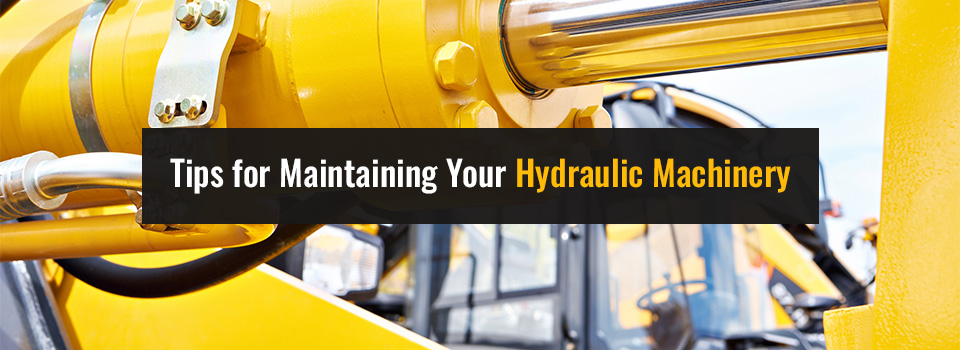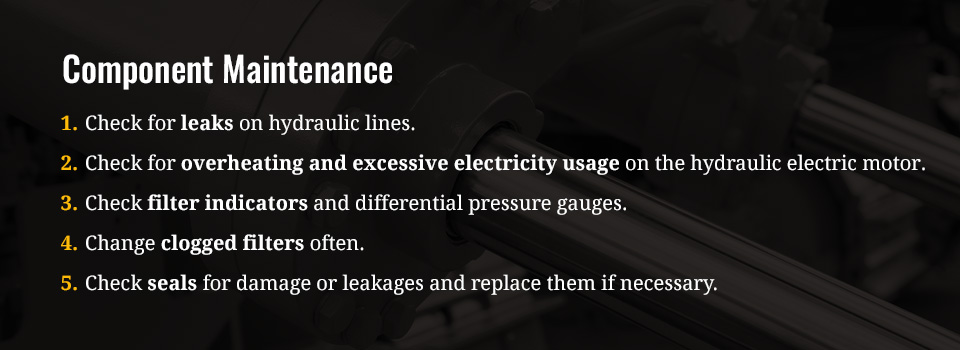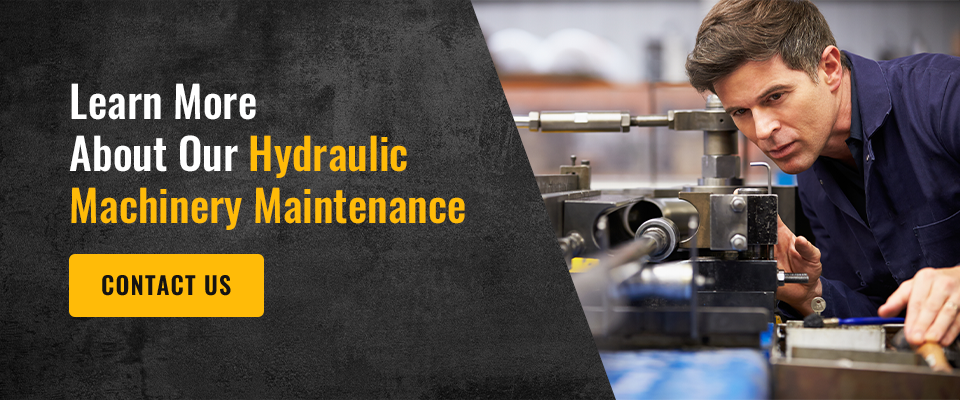Tips for Maintaining Your Hydraulic Machinery

Hydraulic systems are powerful machinery parts that move heavier loads and provide greater force than electrical, pneumatic and mechanical systems. They feature numerous intricate components and a fluid system that enables them to move and lift heavy parts with ease. However, hydraulic systems require regular maintenance to continue operating optimally, maximize their uptime and minimize repairs and replacement costs.
Proper hydraulic system maintenance also enhances workplace efficiency and ensures the safety of workers by reducing the hazards that may cause injuries. Maintenance is essential regardless or the size and complexity of your hydraulic system. So, how do you maintain a hydraulic system?
Explore the Rest of Our Hydraulic Systems Guide:
Hydraulic Fluid Maintenance
The hydraulic fluid powers the hydraulic machinery by transmitting pressure and energy throughout the system. It performs other critical functions, such as reducing friction and lubricating the system to prevent rust and corrosion. It also removes heat and contaminants, such as dirt and debris, from the hydraulic system.
For the fluid to perform these functions effectively, it must remain uncontaminated and clean. Factors such as system overheating and contamination can negatively impact the fluid and reduce its effectiveness. The first step of hydraulic fluid maintenance is visually inspecting the fluid and hydraulic system for:
- System leaks: Check your hydraulic system for liquid pooling or stains, which indicate leaks and fix these before they get out of hand.
- Fluid discoloration: Check for sudden hydraulic fluid color changes that give it a milky or bubbly appearance. This kind of color change indicates contamination by water or air.
- Hydraulic system odor: Be keen to notice a burnt oil smell, which indicates overheated system components.
Filter indicators effectively display the level of contamination using a pop-up indicator or a gauge. Additionally, chemical fluid testing measures levels of contamination that the naked eye can’t detect. It’s performed in a laboratory and reveals the amounts of air, water and dirt in the fluid as well as the chemical reactions that may be taking place.
Here are tips to care for your hydraulic fluid to prevent contamination:
- Monitor system temperature levels: Measure the system’s temperature regularly to ensure it’s not too hot or cold. When it’s too hot, the water in the fluid evaporates, reducing the viscosity and the film thickness, and subsequently increasing friction plus wear and tear of the components. When the temperatures are too low, it causes an increase in viscosity, causing excessive pressure drop and cavitation.
- Check fluid levels regularly: Top off fluids as necessary to prevent cavitation, poor performance and overheating. Most manufacturers also recommend emptying and changing your fluid every 1,000 days or when contamination is detected. Always use the same brand, type and viscosity of your hydraulic fluid recommended by the manufacturer to prevent system failures.
- Maintain a clean environment: Keep the drain lines, reservoir cover, filter bowl, fill cap and breather fill openings clean to prevent contamination. Wipe off any dirt and grime from the exterior of your machinery using a lint-free cloth to prevent the contaminants from entering the system. Additionally, stick to opening your system for maintenance in a clean workspace.
- Inspect the pump and reservoir: Check the inside of the pump and reservoir for contamination and signs of aeration like foam and air bubbles. Aeration threatens to damage the pump and is typically caused by high fluid viscosity, air leaks in the suction seals and low fluid levels.
Component Maintenance

The hydraulic system consists of many components. Here’s how you should maintain some of these main parts.
- Check for leaks on hydraulic lines, which consist of components such as hoses, fittings, tubings, connections and seals. They deteriorate over time as a result of wear and tear, which increases the risk of bursts in the closed system.
- Check for overheating and excessive electricity usage on the hydraulic electric motor using a thermometer. Servicing is necessary to prevent extensive equipment damage if the areas around the housing and rotor bearings are too hot.
- Check filter indicators and differential pressure gauges and replace any that show negative values or signs of wear.
- Change clogged filters often to ensure the system continually performs optimally.
- Check seals for damage or leakages and replace them if necessary. These may be a sign of rod corrosion caused by excess friction.
Preventive Maintenance Tips
While maintaining your hydraulic system is an ongoing process, regular preventive measures are essential to ensure optimal performance. Preventative maintenance involves pre- and post-operation inspections, repairs and replacements. It aims to detect anticipated problems and stop them before they occur to avoid unplanned breakdowns and downtime.
Here are some preventive hydraulic system maintenance tips:
- Test performance: Routine system checks for oil levels, temperatures, case drain flow and actuator speed reveal how your hydraulic system is performing. A slow and steady decrease in performance is normal with any machinery, but rapid performance drops indicate a potentially catastrophic issue with your system that must be fixed rapidly.
- Record routine maintenance activities: You should have an explicit schedule that documents regular preventative maintenance activities such as inspections, servicing and part replacements. You must also keep records of these activities to stay accountable and allow you to prioritize them better.
- Filter hydraulic fluid: Before adding fresh hydraulic fluid to the systems, you need to filter it to reduce the risk of contamination.
- Check and replace hydraulic filters: Regularly check your hydraulic filters before the manufacturer’s recommended date to prevent contamination of the hydraulic fluid. Install high-quality filters to ensure the fluid is efficiently and effectively decontaminated before it starts circulating in the system.
Corrective Maintenance
Corrective maintenance involves taking measures to address problems that have been discovered in the hydraulic system. These problems may be discovered during preventative maintenance and addressed before they get out of hand or after a system breakdown.
An example of corrective hydraulic system maintenance measures is draining all the existing hydraulic system fluid after significant levels of contamination are discovered. Repair and replacements of hydraulic system components such as the pump, accumulator and valves after a breakdown also constitute corrective maintenance measures.
Learn More About Our Hydraulic Machinery Maintenance
Proper hydraulic system maintenance is important to ensure the safety of workers and reduce downtime. At Hard Chrome Specialists, we have a team of professionals with over 75 years of combined experience in the hydraulic pump and hydraulic motor maintenance industry. We offer a range of maintenance and repair services for all types of hydraulic systems.
Our in-house repair services include electropolishing, custom fabrication, chrome plating and electroless nickel plating to extend your machiner’s life span and guarantee reliable long-term performance. Contact us today for more information about our hydraulic maintenance and repair services.

